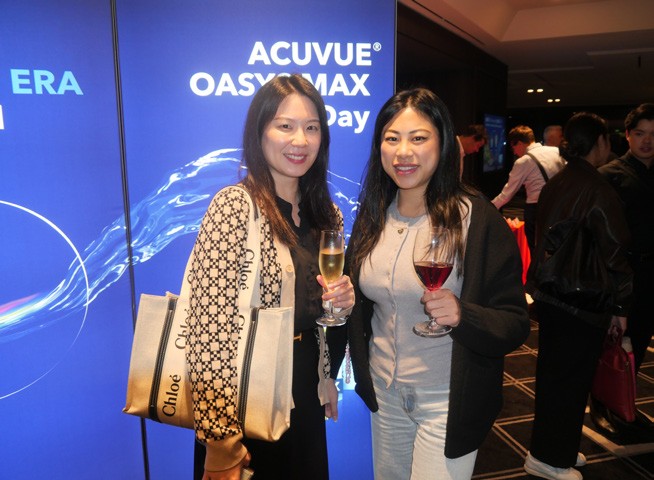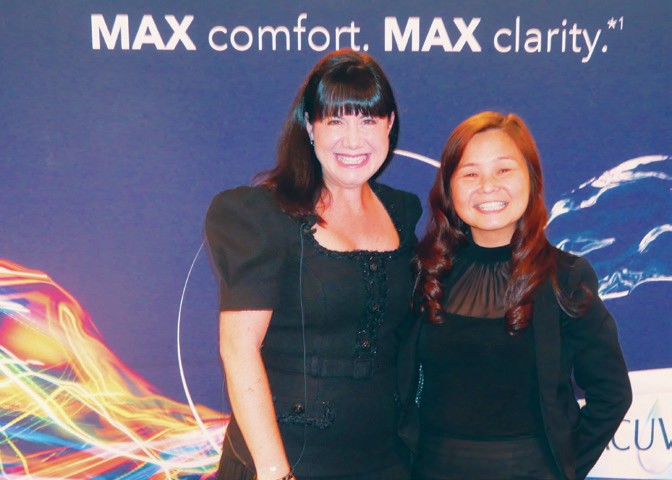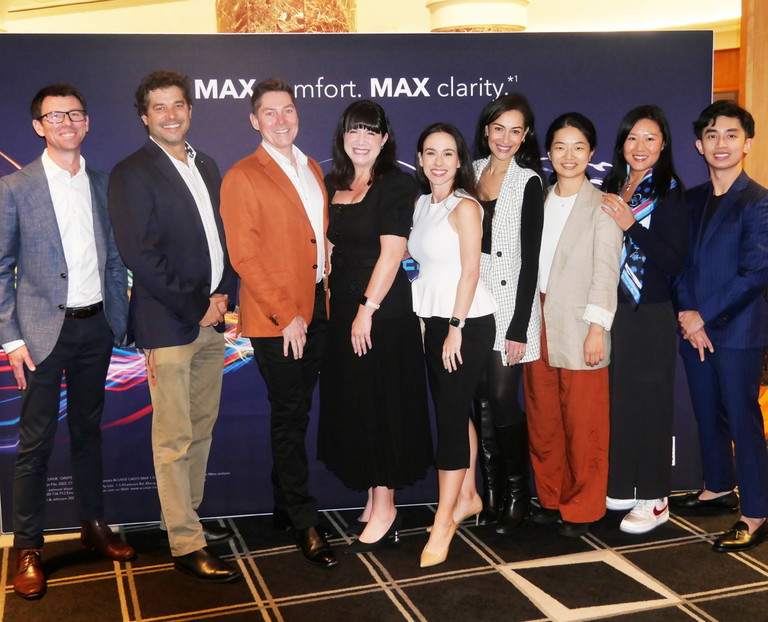mievent

Dr Celia Bloxsom.
Max Performance Min Effort
Johnson and Johnson
WRITER Melanie Kell
Johnson and Johnson Vision recently hosted an educational evening for optometrists in Sydney, titled ‘Max Performance Min Effort’, highlighting the company’s latest premium silicone hydrogel daily disposable family of contact lenses. The event featured presentations from key industry experts – Drs Alex Koutsokeras, Celia Bloxsom, and Margaret Lam – who shared insights on lens technology, patient benefits, and effective communication strategies for practice success.
Dr Koutsokeras, a therapeutically endorsed optometrist who now works with Johnson and Johnson Vision, opened the evening with an overview of the technology behind the Acuvue Oasys Max family of contact lenses, which includes sphere and multifocal options. Dr Koutsokeras explained that the lenses were designed to address increasingly challenging environments faced by modern eyes.
“We are spending way too much time on digital screens. It’s 13 plus hours a day for the average adult, and this is a 32% increase since COVID,” Dr Koutsokeras informed the audience. She observed that reduced blinking when looking at screens – 60% less blinking – significantly increases the risk of dry eye and tear film instability.
Dr Koutsokeras detailed three key technologies that set Max lenses apart from competitors:
1. Tear Stable Technology. The new manufacturing process optimised the distribution of the wetting agent (polyvinylpyrrolidone, PVP) throughout the core and surface of the lens, resulting in “prolonged tear film stability and significantly reduced evaporation off the lens”.
2. OptiBlue Light Filter. Acuvue Oasys Max lenses incorporate a 60% blue-violet light filter, which Dr Koutsokeras described as “the highest in the industry”. The filter targets the 380–450 nanometre range, which causes the most visual disruption.
“This is the light that scatters the most. It’s the most visually disruptive, causing dysphotopsias like light scatter, haloes, starbursts, and even increases our photo stress recovery time,” Dr Koutsokeras explained.
She added that the technology demonstrates measurable benefits, with studies showing reduced starbursts by 23% and reduced haloes by 30%.
3. Pupil Optimised Design. For multifocal lenses, Johnson and Johnson Vision has implemented a design that tailors 100% of parameters to pupil size variations by both age and refraction.
“We are the only manufacturer that tailors 100% of our parameters to pupil size variations by both age and refraction,” Dr Koutsokeras stated, noting that this unique approach (protected by patent) results in a 92% success rate with patients successfully fit in the first pair at the first visit.
CLINICAL EXPERIENCE WITH OASYS MAX ONE DAY
Dr Celia Bloxsom, principal optometrist at Eyeconic Optometry Southport on Queensland’s Gold Coast, and secretary of the Orthokeratology Society of Oceania since 2003, described how her practice has adopted Oasys Max lenses as its “go-to product” for patients experiencing comfort or vision issues.
“I have been lucky enough to have an Oasys Max trial set in practice for about the last 12 months,” Dr Bloxsom told attendees. “This lens has been such a game changer for me in practice.”
As a contact lens wearer for over 30 years, who recently became presbyopic, Ms Bloxsom shared her personal experience with the lenses. From her home in Surfers Paradise she said, “I was absolutely amazed that I could see every single window in the high rises a suburb away through these contact lenses. The clarity and distance vision was exceptionally good.”
Of the three key technologies featured in the lenses, Dr Bloxsom identified Tear Stable Technology as particularly impactful for patients with dry eye conditions. “All contact lens wearers experience dry eye at some point, and the comfort reaction you get out of these lenses is immediate,” she explained.
She presented the case of a patient with superior limbic keratoconjunctivitis (SLK) who had been referred by an ophthalmologist for scleral lens fitting. Instead, Ms Bloxsom fitted the patient with Oasys Max One Day lenses, which provided immediate comfort relief.
“Two weeks later, her superior cornea had much improved, the staining had reduced,” Dr Bloxsom reported. “Three months later, her ptosis had started to recede, the staining had gone, and the neovascularisation was fading.”
Dr Bloxsom spoke about the importance of following the fitting guide for multifocal lenses, and said it is also crucial to correctly identify the patient’s dominant eye.

PSYCHOLOGY OF CONTACT LENS RECOMMENDATION
Dr Lam, Head of Optometry and Professional Services at 1001 Optometry and adjunct senior lecturer at University of New South Wales, presented valuable insights into the psychology of recommending contact lenses and suggested communication strategies to increase patient acceptance.
Dr Lam referenced a major international survey from 2019 that included over 35,000 participants to demonstrate the disconnect between patient expectations and optometrist assumptions.1
“Many patients assume they are not suitable for contact lenses if they are not offered contact lenses,” Dr Lam explained. “Whereas, as optometrists, we think if they don’t mention contact lenses, we’re not going to prescribe them… we assume they don’t want them.”
This misconception leads to missed opportunities, as the survey showed 86% of respondents expected their optometrist to recommend contact lenses with their best vision correction, regardless of cost.
“Healthcare professionals are expected to start this conversation about contact lenses. We’re expected to provide proactive involvement and suggest new treatments, new advice, and new eye care solutions as their optometrists, as opposed to waiting passively for them to raise the topic of contact lenses,” Dr Lam said.

PATIENT EXPERIENCE
Dr Lam shared statistics1 that challenge common practitioner assumptions:
• Almost 90% of survey respondents agreed that “contact lenses have improved my quality of life and allowed me to live my life on my own terms”,
• 80% of respondents, including those 55 and older, agreed they can see much better with contact lenses compared to glasses,
• 86% expect their optometrist to recommend contact lenses with their best vision correction, regardless of cost, and
• Nearly 70% expected a recommendation of contact lenses that best supports eye health.
These findings contrast sharply with practitioner perceptions, as Dr Lam pointed out: “Only 50% of optometrists believe their toric contact lens patients get the same quality of vision as their glasses. But 90% of our patients are saying, ‘my contacts are better’… We actually aren’t doing too bad a job at all… we’ve got to have more faith in ourselves as contact lens practitioners.”
She said proactively offering contact lenses is good for business because, “up to 88% of patients agree to try them, which results in 2.5 times more patients likely to have a contact lens fitting, leading to 2.5 times more patients purchasing contact lenses as well as purchasing glasses, not one or the other”.

Drs Celia Bloxsom and Margaret Lam.
EFFECTIVE COMMUNICATION STRATEGIES
Dr Lam said utilising patient-friendly language that refers to tangible benefits tailored to patients’ lifestyles, rather than medical jargon, is important. Additionally, recommendations should be tailored to each patient’s specific needs and lifestyle factors.
“Make a compelling, tailored, and personalised recommendation that’s not overly technical, but speaks to the lifestyle needs of your individual patients. This is what helps us to prescribe contact lenses in a meaningful way that can help improve our patient’s lives,” Dr Lam advised.
The event concluded with interactive workshops where attendees practised recommending contact lenses using patient-friendly language and addressing common objections.
